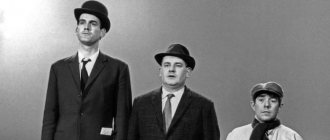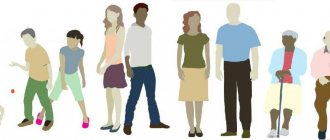Meaning of the term and general characteristics
The word “status” itself dates back to Ancient Rome. Then it had more of a legal connotation, rather than a sociological one, and denoted the legal status of an organization.
Nowadays, social status is a person’s position in a particular group and society as a whole, giving him certain rights, privileges, as well as responsibilities in relation to other members.
It helps people interact better with each other. If a person of a certain social status does not fulfill his duties, then he will be held responsible for it. Thus, an entrepreneur who sews clothes to order will pay a penalty if the deadlines are missed. In addition, his reputation will be ruined.
Examples of the social status of one person are a schoolboy, son, grandson, brother, member of a sports club, citizen, and so on.
This is a certain characteristic of a person according to his professional qualities, financial and marital status, age, education and other criteria.
A person can simultaneously belong to several groups at once and, accordingly, play not one, but many different roles. That's why they talk about status sets. It is unique and individual for each person.
Concept of social status
The most important element in the life and activity of any individual is his social position.
It determines a person’s status, his social roles, and areas of activity. The influence of members of society on each other, their life activity, development and improvement depends on it. Definition 1
Social status is the status of an individual, determined by his marital status, official and professional role, origin, gender, social role.
Social status is formed based on the financial status of the individual, his age, gender, education, existing abilities and skills, and creative potential.
Also, the social position that an individual receives in society can be determined based on the customs and traditions of a particular nation or state as a whole.
Note 1
It is worth noting that social position does not determine a person’s membership in a particular social group. Members of the same social group can have completely different social positions.
Finished works on a similar topic
- Coursework Types of social statuses 460 rub.
- Abstract Types of social statuses 260 rub.
- Test work Types of social statuses 250 rub.
Receive completed work or specialist advice on your educational project Find out the cost
Depending on the position occupied, a person is assigned to a certain social class.
Social position is characterized by a hierarchical structure, i.e. There are several levels that a person can occupy in society.
Let's consider the levels of social status:
- Natural position. This is the status an individual received at birth. This includes: gender, race, nationality. These criteria determine a certain social role that a person will perform throughout his life. Innate social position is stable and unchangeable.
- Acquired position. This is the status that a person acquires in the course of his life. This includes his career and achievements in it, level of financial security, and position held. A person achieves this position through his efforts, intellectual and physical qualities, and talents. This situation is characterized by instability, i.e. it can change during the life process, both for the better and for the worse.
- Prescribed position. It is provided to a person, regardless of his aspirations and interests, actions and deeds. This situation can be determined based on the age specifics of personality development, or reflect its origin. The status of such a person can be either innate or acquired.
Too lazy to read?
Ask a question to the experts and get an answer within 15 minutes!
Ask a Question
Types of social statuses, examples
Their range is quite wide. There are statuses received at birth, and others acquired during life. Those that society ascribes to a person, or those that he achieves through his own efforts.
The basic and passing social status of a person is distinguished. Examples: the main and universal one, in fact, is the person himself, then comes the second - this is the citizen. The list of main statuses also includes consanguinity, economic, political, and religious. The list goes on.
Episodic - a passerby, a patient, a strike participant, a buyer, an exhibition visitor. That is, such statuses for the same person can change quite quickly and repeat periodically.
Can a person have no social status?
Any individual has a couple of three statuses, which are absolutely impossible to lose. One will be replaced by another replacing him. A schoolchild, having completed the eleventh grade, becomes a student. A citizen who buys real estate turns from a buyer into an owner. He was the chief physician, was promoted, and became deputy minister of health.
The more social positions a person has, the more diverse and interesting his life.
Prescribed social status: examples
This is what a person receives from birth, biologically and geographically given characteristics. Until recently, it was impossible to influence them in any way and change the situation. Examples of social status: gender, nationality, race. These set parameters remain with a person for life. Although in our progressive society they have already taken aim at changing gender. So one of the listed statuses to some extent ceases to be prescribed.
Much of what is related would also be considered a prescribed species. This is father, mother, sister, brother. And husband and wife are already acquired statuses.
History of social statuses in Russia
In the Russian Empire, the following main social statuses were identified, enshrined in documents and indicated as “rank”:
- peasant
- tradesman
- personal honorary citizen
- hereditary honorary citizen
- personal nobleman
- hereditary nobleman
Moreover, if there was any rank, then instead of the indicated categories of the population, it was the rank that was indicated.
In the Soviet Union, the following main social statuses were identified, enshrined in documents and indicated as “social status”:
- peasant
- worker
- employee
The category of employees included everyone who had a higher education or graduated from a technical school. The category of workers included everyone who did not have the specified education. The category of peasants included residents of rural settlements engaged in agriculture who did not have the above education.
When entering a job (service), a “personal personnel registration sheet” was filled out, which included a column (No. 6) “Social origin”. Usually this column was filled in with one of the following options: “from peasants”, “from workers”, “from employees”. As a rule, the social status of the head of the family was indicated. [4]
Achieved status
This is what a person achieves himself. By making efforts, making choices, working, studying, each individual ultimately comes to certain results. His successes or failures are reflected in the way society assigns him the status he deserves. Doctor, director, company president, professor, thief, homeless person, tramp.
Almost every achieved social status of an individual has its own insignia. Examples:
- for the military, security forces, internal troops - uniform and shoulder straps;
- doctors wear white coats;
- people who have broken the law have tattoos on their bodies.
The influence of social status on personality
Roles in society are rarely superficial. These can only be those types of social statuses that are assigned for a short period of time: passerby, patient, buyer.
Basically, belonging to a certain role leaves a deep imprint on a person’s entire life. The status to which the subject attaches the greatest importance has a special influence. For example, a professor, musician, athlete, serial killer, etc. Having taken on a serious role, a person gradually begins to change, acquiring the character traits and skills necessary to fulfill it.
A doctor, if he has worked in this field for a long time, evaluates people completely differently than a police officer. The surgeon will evaluate the person according to his parameters, formed by his professional activities. Likewise, an investigator, having worked for years among hardened criminals, will never be the same.
Roles in society
A person’s social status will help to understand how this or that object will behave. We constantly find examples and confirmation of this. Expectations in the behavior and appearance of an individual depending on his membership in a certain class are called social role.
Thus, the status of a parent obliges him to be strict but fair to his child, to bear responsibility for him, to teach, to give advice, to prompt, to help in difficult situations. The status of a son or daughter is, on the contrary, a certain subordination to parents, legal and material dependence on them.
But, despite some patterns of behavior, every person has a choice of what to do. Examples of social status and its use by an individual do not fit one hundred percent into the proposed framework. There is only a scheme, a certain template, which each individual implements according to his abilities and ideas.
It often happens that it is difficult for one person to combine several social roles. For example, a woman’s first role is a mother, wife, and her second role is a successful businesswoman. Both roles require an investment of effort, time, and full dedication. A conflict arises.
An analysis of the social status of an individual and an example of his actions in life allow us to conclude that it reflects not only the internal position of a person, but also affects his appearance, manner of dressing and speaking.
Let's look at examples of social status and the standards associated with it in appearance. Thus, the director of a bank or the founder of a reputable company cannot appear at work in sweatpants or rubber boots. And the priest should come to church in jeans.
The status that a person has achieved forces him to pay attention not only to appearance and behavior, but also to choose his social circle, place of residence, and study.
What is a social role
By social role we mean expectations from a person, a series of actions that he must take to comply with his position in society.
The difference between a person’s social status and his social role lies in his activities, behavior, and actions. Each member of society is required to conform to his role, or model of behavior. This provides a comfortable level of trust, orderliness and predictability in relationships between people. A person must play his role and perform the associated responsibilities with integrity.
It is not permissible to go beyond the status image, so as not to damage your reputation in the eyes of society or a certain circle. Thus, a person unwittingly becomes a hostage to his own social role.
The performance of roles is subjective and varies depending on the personal qualities of the individual. The same leaders can be democratic, authoritarian, inconsistent, or fanatical formalists. Officials, law enforcement officers and doctors - both decent and dishonest.
And even parents raise children in different ways: from overprotection to complete permissiveness. And art knows examples of different embodiments of the same character by different actors, artists or writers using completely different expressive techniques.
Important!
The social role of a person during his life can change repeatedly in the direction of both increasing and decreasing status.
This is facilitated by age-related changes, luck, hard work, coincidence of circumstances, professional growth, changes in the type of activity, personal life events, loss of health and disability, social processes, and so on. There is also such a phenomenon as status incompatibility.
This happens when a person has different status in different social groups and plays different social roles. For example, in a society of like-minded people he is an authoritative person, but at work or in the family he does not meet with respect. Some, disillusioned with the ideas accepted in their circle, leave it, but cannot find a new environment or are on the verge of breaking with their previous environment. As a result, his way of life becomes more and more marginal: a person lives based on his own code and values, but at the same time he feels the incompatibility of his ideas with the way of society. This often leads to mental disorder. An extreme case of marginalization is the transformation of a person into a lumpen, a tramp, a declassed element.
The same thing happens when someone, wanting to climb the social ladder, finds himself as if isolated from a new team - among this public he is a stranger, out of place, despite his professionalism. As a result, his relationships with loved ones usually deteriorate.
Another classic example of status incompatibility is when a young mother tries to build a career, depriving her closest people of attention. First of all, the child and the emotional relationship with the husband suffer from this, which worsens the moral and psychological climate in the family.
Moral Sadist - Who is This in Psychology?
Prestige
Not the least role in the destinies of people is played by such a concept as prestige (and positive, from the point of view of the majority, social status). We can easily find examples in the questionnaire that students of all high schools write before entering higher education institutions. They often make their choice based on the prestige of a particular profession. Nowadays, few boys dream of becoming an astronaut or pilot. And once upon a time it was a very popular profession. They choose between lawyers and financiers. This is how time dictates.
Conclusion: a person develops as an individual in the process of mastering different social statuses and roles. The brighter the dynamics, the more adapted to life the individual will become.
Social status and role, main characteristics and varieties.
⇐ PreviousPage 3 of 8Next ⇒The role theory of personality occupies a significant place in the sociology of personality. The main provisions of this theory were formulated by American sociologists J. MEAD AND R. MINTOP.
The role theory of personality describes its social behavior with two main concepts: “social status” and “social role”. Status is the position occupied by an individual or social group in society. A person can have several statuses. But only one determines his position in society. This status is called main (determined by position).
Sociologists distinguish:
1. Prescribed status - a status imposed by society, regardless of the efforts and merits of the individual (ethnic origin, place of birth).
2. Acquired status - status is determined by the efforts of the person himself (writer, general director).
Also highlighted:
1. Natural status - presupposes significant and relatively stable characteristics of a person (men and women, childhood, adolescence, maturity).
2. Professional and official - the basic status of the individual, fixes the social, economic and production-technical position of a person (banker, engineer, lawyer, etc.)
A social role is a set of actions that a person must perform in accordance with his status data. Each status usually includes a number of roles. The set of roles arising from a given status is called a role set.
Sociology distinguishes:
1. Institutionalized are leading ones that arise on the basis of the social structure of society. These roles are also historically determined. So, a medieval knight, musketeers, archers, yachtsmen, etc.
2. Conventional - roles are determined and arise arbitrarily in group interactions and show a subjective coloring. A fussy, nervous person.
The social role should be considered in two aspects:
• role expectation;
• role performance
There is never a coincidence between these two aspects, but each of them leaves a strong imprint on the personality. Our roles are determined primarily by what others expect of us.
There are situations when a person is faced with two or more simultaneous demands in which the performance of one of the roles makes it impossible for him to perform other roles.
13 . Social status is a person’s social position within a group or society, associated with certain of his rights and responsibilities.
Types of statuses
1) general (universal, basic ) - a key status that determines the social status and significance of a person associated with certain rights and responsibilities. This can be the status of a person (“Man – that sounds proud”), a member of a given society, a citizen (citizen of Russia), or the status position of an individual. For children, the main status is age; similarly, in many societies the primary status is gender. The basic status forms the frame within which our goals are formed and our learning takes place.
2) prescribed (ascriptive ) - statuses inherited from birth, for example, nationality, social origin, place of birth.
3) acquired (achieved) - statuses acquired by an individual in society thanks to his own efforts, for example, professor, doctor, actor, student, policeman, pickpocket, etc.
Statuses can be formalized (for example, director of a plant) or informal (leader of a company of close friends), which depends on whether a particular function is performed within the framework of formalized or informal social institutions.
Explicit status is a status position activated in a particular social context that is most important for actions and interactions in that particular area.
Hidden statuses are all other positions that the subject occupies, but which are not currently activated.
It is through an explicit position that others identify the subject, imagining him as a partner, establishing interaction with him. Easier and more correct “recognition” of the subject is facilitated by certain external attributes inherent in such an obvious position (for example, wearing a uniform).
The life of each person consists of many social positions, which he occupies not simultaneously, but one by one (for example, a baby - a child - a teenager - a mature person - an old man). In all such cases, we are talking about a sequential change of status. When it comes to a professional context, about service, work, this sequence is called a career.
There is a hierarchy of statuses. The allocation of the main status self-determines a person socially. We must be able to orient ourselves, figure it out, and decide which statuses are the most important for us and which are less significant.
The ranking of statuses is determined by social prestige. Prestige is a hierarchy of statuses shared by society and enshrined in culture and public opinion.
A society needs a balance of statuses, otherwise it cannot function normally.
Status has a significant impact on the perception of a person by others. One American researcher introduced the same man to students in several classes at his college. In one class this man was introduced as “a student from Cambridge”, in the second as a “laboratory assistant”, in a third as a “psychology teacher”, in a fourth as a “PhD from Cambridge”, in the last as a “professor from Cambridge” " After the foreign guest left, the students were asked to estimate his height as accurately as possible. It turned out that as he climbed the ladder of academic ranks, the guest invariably "increased in height", so that the last group estimated his height to be 5 inches higher than the first. Meanwhile, the height of the teacher, who went with the guest and whose title did not change, was assessed exactly the same in all classes.
Social role – (according to R. Merton) the expectation of behavior typical for people of a given status in a given society.
A social role is a fairly complete (but not all-encompassing) behavioral characteristic. For example, the status of a university teacher comes with certain rights and obligations, most of which are legally fixed. The social role of a teacher includes how he should behave with students, colleagues, the level of general culture, etc., i.e., this is the expectation of the norm of behavior of a person of a certain status.
The essential characteristics of a social role include its functional expediency, as well as the correspondence of role expectations to a certain culture and value system. Functional expediency gives rise to many common features, in particular, in socio-professional role models. Teachers, for example, everywhere must be intelligent people; they must be characterized by a certain type of behavior that ensures the effectiveness of upbringing and teaching. But as far as the sociocultural aspect of the role is concerned, differences often arise here, and quite serious ones at that. This is due to the value system of each culture, as well as how high the prestige of a particular status is in a given society. A teacher, his status in some countries has always been high, in other countries a teacher can be perceived as a loser, an intellectual and a laborer.
The social role as a means of describing the relationship between the individual and society makes it possible in many ways to comprehend social life in a new way, to establish in scientific and logical ways the mechanisms for connecting the individual to complex social formations.
Types of roles (according to J. Moreno)
1) “psychosomatic” roles, when behavior is associated with basic biological needs, and the playing of roles is objectively of an unconscious nature;
2) “psychodramatic” roles, when an individual’s behavior is structured in accordance with the specific requirements of a given social environment;
3) “social” roles, when a person behaves as expected from a representative of a particular social category (mother, worker, Christian).
The role is already status. A status is a set of roles. Role set – (R. Merton) a set of roles arising from a given status. The role set includes formal and informal roles. The variety of roles gives rise to internal conflicts of the individual, that is, role conflicts or role tension.
14. Social norms are a set of requirements and expectations that a social community (group), organization, society places on its members in their relationships with each other, with social institutions in order to carry out activities (behavior) of the established pattern. These are universal, permanent regulations that require their practical implementation. They arise due to the need for a certain behavior. The most important characteristic of a norm is its generally accepted and universal nature.
A social norm is one of the complex forms of expression of social relations. It consists of many elements, each of which has different properties that can also change over a fairly wide range. The social norm embodies the public will, a conscious social necessity. This is precisely why it differs from the so-called quasi-norms. The latter are most often of a rude, violent nature, fettering initiative and creativity.
A social norm performs the following functions. 1. Norms are designed to guide and 2. regulate people’s behavior in various situations. The regulatory effect is that the norm establishes boundaries, conditions, forms of behavior, the nature of relationships, goals and methods of achieving them. 3. socializes the personality; 4. evaluates behavior; 5. Prescribes models of proper behavior. 6. A means of ensuring order.
The main social purpose of a social norm can be formulated as the regulation of social relations and people's behavior. Regulating relationships through social norms ensures voluntary and conscious cooperation of people.
The following groups of norms can be roughly distinguished: 1. By carrier: universal, O, group norms. 2. By field of activity: economic norms, political norms, cultural norms, legal norms. 3. There are formal and informal norms. 4. By scale of action: general and local. 5. By the method of support: based on internal convictions, public opinion, coercion.
The main types of norms in order of increasing their social significance. 1. Customs are simply familiar, normal, most convenient and fairly widespread ways of group activity. New generations of people adopt these social ways of life partly through unconscious imitation and partly through conscious learning. At the same time, the new generation chooses from these methods what seems necessary for life. 2. Moral norms - ideas about right and wrong behavior that require certain actions and prohibit others. At the same time, members of the social community where such moral norms operate share the belief that their violation brings disaster to the entire society. Members of another social community may, of course, believe that at least some of the group's moral standards are unreasonable. Moral norms are passed on to subsequent generations not as a system of practical benefits, but as a system of unshakable “sacred” absolutes. As a result, moral standards are firmly established and carried out automatically. 3. Institutional norms - a set of specially developed norms and customs relating to important aspects of the activities of the organization, embodied in social institutions. 4. Laws are simply reinforced and formalized moral norms that require strict implementation
Violation of norms causes a specific and clear negative reaction from the organization, its institutional forms, aimed at overcoming behavior deviating from the norm. Types of sanctions - negative or positive, i.e. punishment or reward. However, normative systems are not fixed and forever data. Norms change, and attitudes towards them change. Deviation from the norm is as natural as following it. Conformism - complete acceptance of the norm; deviation is a deviation from it. Sharp deviations from the norm threaten the stability of O.
In general terms, the process of formation and functioning of social norms can be conventionally represented in the form of successively interconnected stages. The first stage is the emergence and constant development of norms. The second is the individual’s understanding and assimilation of the system of social norms of society, a social group, an individual, in other words, this is the stage of a person’s inclusion in society, his socialization. The third stage is real acts, the specific behavior of the individual. This stage is the central link in the mechanism of social-normative regulation. It is in practice that it is revealed how deeply social norms have entered the consciousness of an individual. The fourth stage of the norm functioning process is the assessment and control of human behavior. At this stage, the degree of compliance or deviation from the norm is identified.
Social norms are socially approved or legally enshrined rules, standards, patterns that regulate the social behavior of people. Therefore, social norms are divided into legal norms, moral norms and social norms themselves.
Legal norms are norms formally enshrined in various types of legislative acts. Violation of legal norms involves legal, administrative and other types of punishment.
Moral norms are informal norms that function in the form of public opinion. The main tool in the system of moral norms is public censure or public approval.
Social norms usually include:
group social habits (for example, “don’t turn up your nose in front of your own people”);
social customs (eg hospitality);
social traditions (for example, the subordination of children to parents),
social mores (manners, morals, etiquette);
social taboos (absolute prohibitions on cannibalism, infanticide, etc.). Customs, traditions, mores, taboos are sometimes called general rules of social behavior.
15. Social control is, on the one hand, a mechanism of social regulation, a set of means and methods of social influence, and on the other hand, the social practice of their use.
In general, the social behavior of an individual occurs under the control of society and the people around him. They not only teach the individual the rules of social behavior in the process of socialization, but also act as agents of social control, monitoring the correct assimilation of patterns of social behavior and their implementation in practice. In this regard, social control acts as a special form and method of social regulation of people’s behavior in society. Social control is manifested in the subordination of an individual to the social group into which he is integrated, which is expressed in meaningful or spontaneous adherence to social norms prescribed by this group.
Social control consists of two elements - social norms and social sanctions.
Social norms are socially approved or legally enshrined rules, standards, patterns that regulate people’s social behavior.
Social sanctions are means of reward and punishment that encourage people to comply with social norms.
Types of Social Control
In sociology, two main processes of social control are distinguished: the application of positive or negative sanctions for the social behavior of an individual; interiorization (from the French interiorisation - transition from outside to inside) by an individual of social norms of behavior. In this regard, external social control and internal social control, or self-control, are distinguished.
External social control is a set of forms, methods and actions that guarantee compliance with social norms of behavior. There are two types of external control - formal and informal.
Formal social control, based on official approval or condemnation, is carried out by government bodies, political and social organizations, the education system, the media and operates throughout the country, based on written norms - laws, decrees, regulations, orders and instructions. Formal social control may also include the dominant ideology in society. When we talk about formal social control, we primarily mean actions aimed at making people respect laws and order with the help of government officials. Such control is especially effective in large social groups.
Informal social control, based on the approval or condemnation of relatives, friends, colleagues, acquaintances, public opinion, is expressed through traditions, customs or the media. Agents of informal social control are social institutions such as family, school, and religion. This type of control is especially effective in small social groups.
In the process of social control, violation of some social norms is followed by very weak punishment, for example, disapproval, an unfriendly look, a grin. Violation of other social norms is followed by severe punishments - death penalty, imprisonment, expulsion from the country. Violation of taboos and legal laws is punished most severely; certain types of group habits, in particular family ones, are punished most leniently.
Internal social control is the individual’s independent regulation of his social behavior in society. In the process of self-control, a person independently regulates his social behavior, coordinating it with generally accepted norms. This type of control manifests itself, on the one hand, in feelings of guilt, emotional experiences, “remorse” for social actions, and on the other hand, in the form of an individual’s reflection on his social behavior.
An individual’s self-control over his own social behavior is formed in the process of his socialization and the formation of socio-psychological mechanisms of his internal self-regulation. The main elements of self-control are consciousness, conscience and will.
Human consciousness is an individual form of mental representation of reality in the form of a generalized and subjective model of the surrounding world in the form of verbal concepts and sensory images. Consciousness allows an individual to rationalize his social behavior.
Conscience is the ability of an individual to independently formulate his own moral duties and demand that he fulfill them, as well as to make a self-assessment of his actions and deeds. Conscience does not allow an individual to violate his established attitudes, principles, beliefs, in accordance with which he builds his social behavior.
Will is a person’s conscious regulation of his behavior and activities, expressed in the ability to overcome external and internal difficulties when performing purposeful actions and deeds. Will helps an individual overcome his internal subconscious desires and needs, act and behave in society in accordance with his beliefs.
In the process of social behavior, an individual has to constantly struggle with his subconscious, which gives his behavior a spontaneous character, therefore self-control is the most important condition for people’s social behavior. Typically, individuals' self-control over their social behavior increases with age. But it also depends on social circumstances and the nature of external social control: the stricter the external control, the weaker the self-control. Moreover, social experience shows that the weaker an individual’s self-control, the stricter external control should be in relation to him. However, this is fraught with great social costs, since strict external control is accompanied by social degradation of the individual.
In addition to external and internal social control of an individual’s social behavior, there are also: 1) indirect social control, based on identification with a law-abiding reference group; 2) social control, based on the wide availability of a variety of ways to achieve goals and satisfy needs, alternative to illegal or immoral ones.
16.
Norm - in a number of sciences about living organisms, including humans (medicine, biology, as well as sociology, etc.) is considered as a certain reference point, standard, standard - for comparison with other options for the state of a living object (objects) (which can be considered as deviation, pathology).
Pathology (from the Greek παθος - suffering, pain, illness and λογος - study) is a painful deviation from the normal state or development process. Pathologies include processes of deviation from the norm, processes that disrupt homeostasis, diseases, dysfunctions (Pathogenesis).
⇐ Previous3Next ⇒










